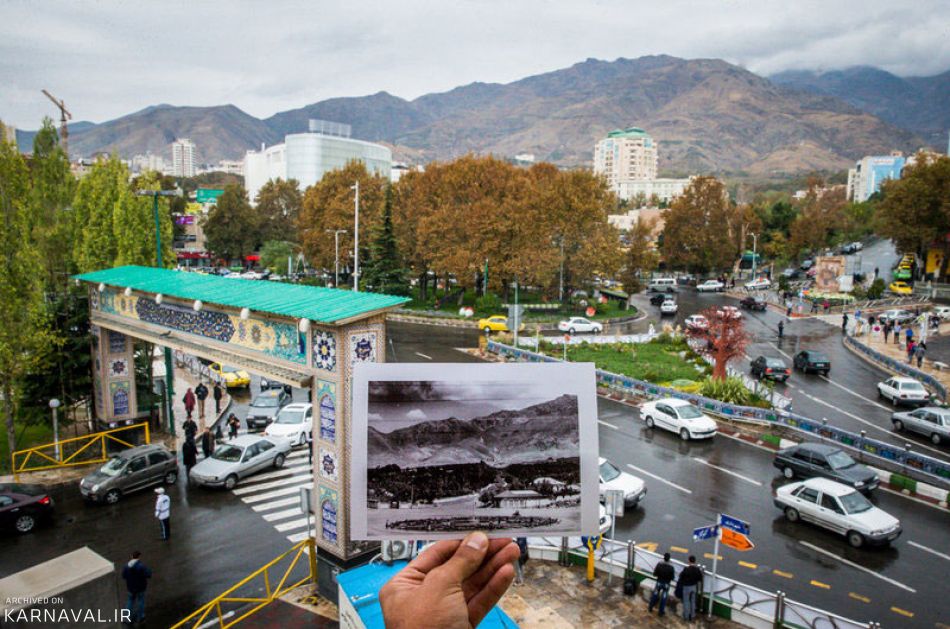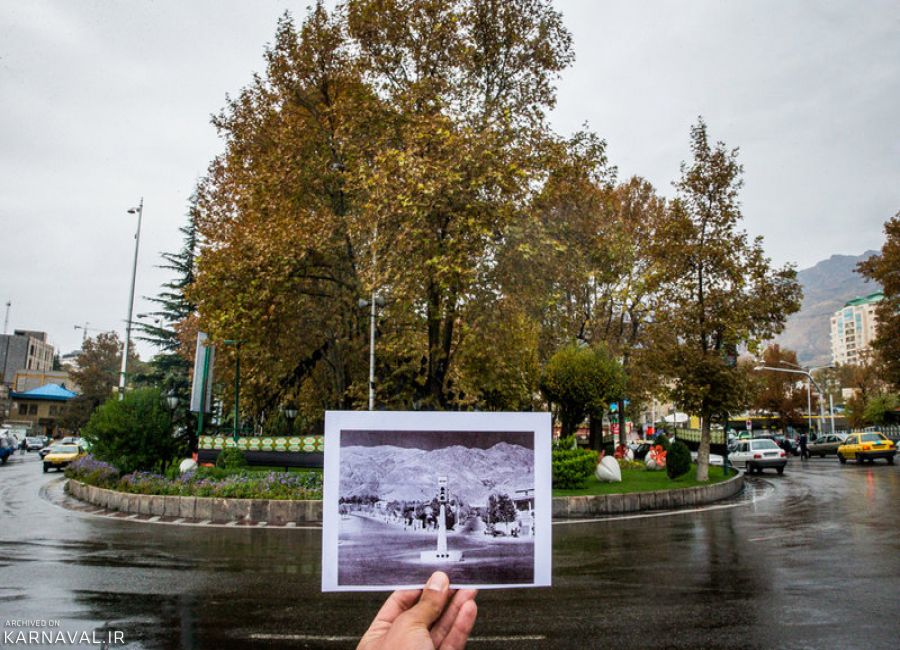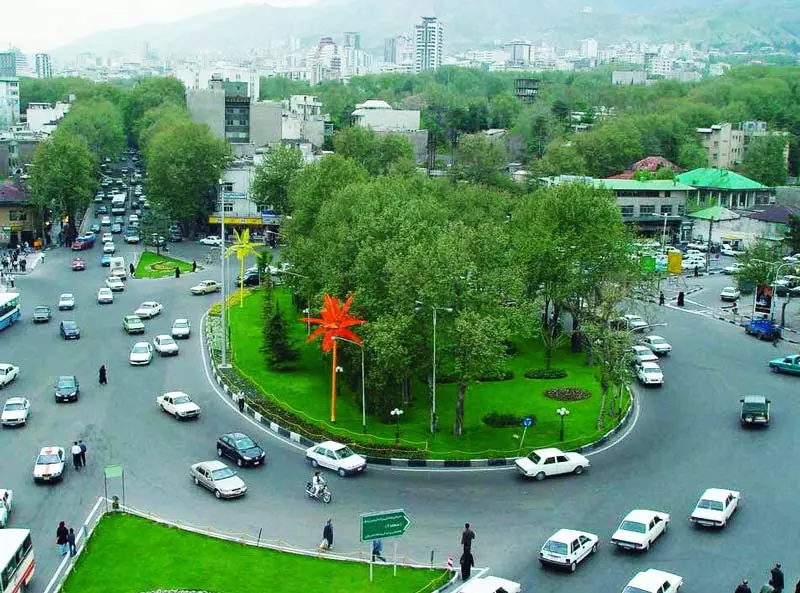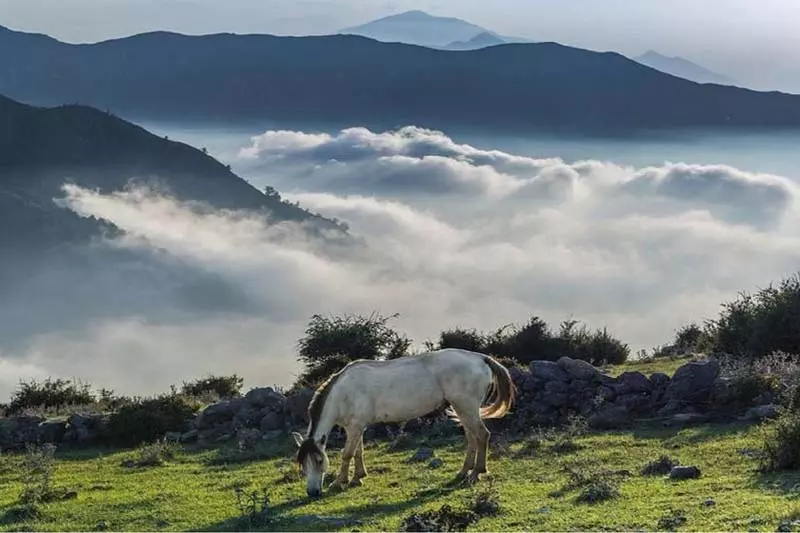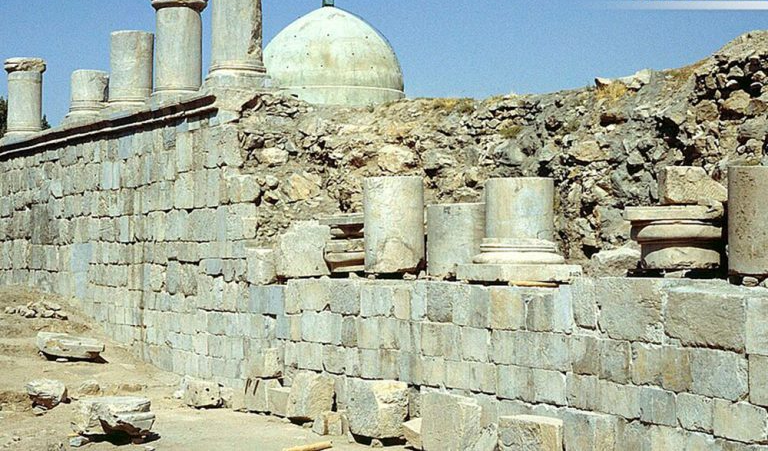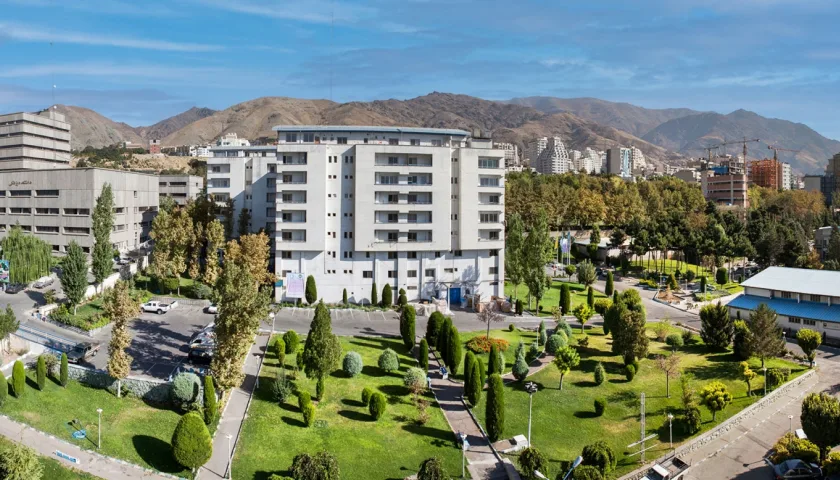Tajrish Square ،Discovering Tajrish: From Past to Present
Tajrish Square, located at the northern end of Valiasr Street, is one of the oldest areas in the capital with a variety of attractions, restaurants, cafes, and traditional and modern shopping centers.
Tajrish Square is one of the northern squares of Tehran in the Shemiranat region and Tajrish district. Situated in the southern foothills of the Alborz mountain range, it lies in the northern part of the capital, making its climate cooler compared to other areas of Tehran. Surrounding Tajrish Square are areas such as Qeytarieh, Elahiyeh, Dezashib, Niavaran, Jafarabad, Darband, and Zaferanieh. Tajrish Square boasts numerous tourist attractions, from historical buildings to bustling markets and diverse restaurants, making it one of Tehran’s best sightseeing spots.
Not too long ago, Tajrish Square had a different appearance from its current form. In the past, only the traditional Tajrish market operated in this square, with no sign of the modern and luxurious malls present today. Food vendors were simpler, and tourists would enjoy their favorite foods along the streets or on benches. Nowadays, a single day is not enough to visit Tajrish Square’s tourist attractions, and hours must be spent exploring its sights. If you’re interested in learning more about this square and its attractions, join us to gather comprehensive information about Tajrish Square.
Everything about Tajrish Square Tehran:
Where is Tajrish Square?
Access routes to Tajrish Square
About Tajrish Square
History of Tajrish Square
Cafes and restaurants in Tajrish Square
Attractions of Tajrish Square
Nearby attractions of Tajrish Square
Where is Tajrish Square located?
Address: Tehran Province, Shemiranat County, Lavasanat District, Tajrish Area (View on map)
Tajrish Square is situated in the center of Shemiranat County in the northern part of Tehran Province. This square is the most important and famous part of the Tajrish district of Tehran, serving as the primary commercial hub in this neighborhood.
Quds Square is located to the right of Tajrish Square, and Shahrdari Street connects these two squares. Tajrish Square and the entire Tajrish area fall within the jurisdiction of Tehran’s first municipal district. Two of Tehran’s prominent streets, Valiasr and Shariati, which are among the main thoroughfares connecting the south to the center and north of Tehran, provide convenient access to this square. Shariati Street leads to Quds Square at its end, while Valiasr Street terminates at Tajrish Square.
Tajrish Square is located in the northern part of the Tajrish area and is bordered by Darband, Jafarabad, and Saadabad to the north, Qeytarieh and Elahiyeh to the south, Dezashib and Niavaran to the east, and Zaferanieh to the west. This square is the most famous square in Shemiranat, with seven streets named Shahrdari, Fanakasro, Jalalvand, Gholam Jafari, Maleki (Saadabad), Valiasr, and Shahid Darbandi leading to it.
Access to Tajrish Square
To reach Tajrish Square, you need to navigate yourself towards the northern part of Tehran using either Shariati or Valiasr streets. The northern ends of these streets lead you to the Tajrish area and the squares of Quds and Tajrish. Shariati and Valiasr streets are busy and congested thoroughfares, and crossing them during weekdays can be time-consuming whether by personal vehicles, taxis, or buses.
BRT buses operate on Shariati and Valiasr streets. Some sections of these streets are one-way, allowing passage for buses only. Various taxis also commute from different parts of the city to Tajrish Square, utilizing alternative routes and alleyways to reach the square.
To avoid the traffic on Shariati and Valiasr streets, depending on your starting point, you can utilize parallel highways and alternative routes.
Sadr Expressway (east-west) and Modarres (north-south) highways are the closest expressways to Tajrish Square. These highways provide convenient access to Shariati and Valiasr streets. Depending on your direction towards Tajrish Square, you can traverse a part of the route on these highways and divert towards Tajrish using suitable exits.
Tajrish Square is not within the main Tehran traffic plan area; however, the stretch between Fatemi and Motahari streets on Valiasr Street falls under the traffic plan zone. If you intend to travel to Tajrish Square by private car, specify your desired route towards entering the main traffic plan area. Considering the congested routes leading to Tajrish, the best way to access this square is by BRT buses and metro lines.
Tajrish Square via Metro
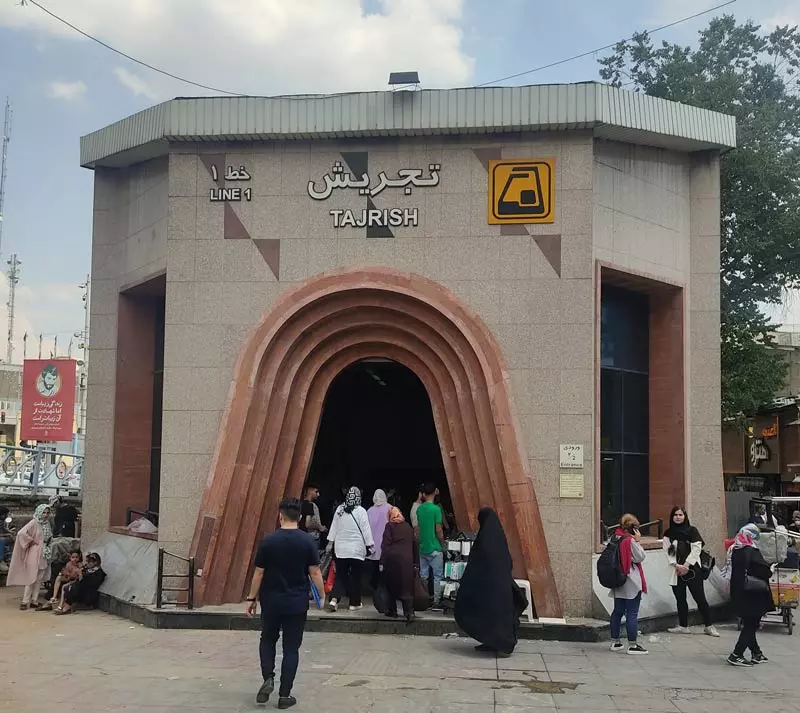
One of the best ways to access Tajrish Square is by using metro lines. Due to the high traffic on Shariati and Valiasr streets, many tourists and residents of the Tajrish area use the metro to reach this square.
Tajrish Metro Station on Tehran Metro Line 1 is the first station on the north-south route. This metro line intersects with all Tehran metro lines in the downtown area, providing high accessibility to Tajrish Square from most parts of the capital.
Tajrish Metro Station is located at Quds Square, and by walking for about 10 minutes, you can reach Tajrish Square. The design of Tajrish Square Metro Station on Tehran Metro Line 1 is currently underway. The exact operational time of this station is not known, but in the future, this station will be added to Tehran Metro Line 1.
About Tajrish Square
The Tajrish area is considered one of the oldest neighborhoods in Tehran, owing to its location in the northern heights of Tehran, which has historically provided a pleasant climate for the city’s residents.
The average elevation of the Tajrish area is approximately 1,600 meters above sea level, and during the cold seasons, this area experiences more precipitation compared to other parts of Tehran, especially the central and southern neighborhoods.
The commercial, cultural, and recreational centers of Tajrish Square attract the attention of many tourists throughout the year. This square is among the areas in the capital that are never quiet. During the day, the commercial centers and the influx of tourists make it bustling, and at night, the street markets and food stalls in Tajrish Square remain lively.
Tajrish Square hosts many hikers on weekends and holidays. Access to the mountains of Darband and Golabdareh is facilitated from this square. Tajrish Bazaar, Tekiyeh Tajrish, and Imamzadeh Saleh are also among the most important tourist attractions in Tajrish Square. You will also pass by this square or streets leading to it when visiting Saadabad Palace Museum, Ferdows Garden, and Zahiroldoleh Tomb.
History of Tajrish Square
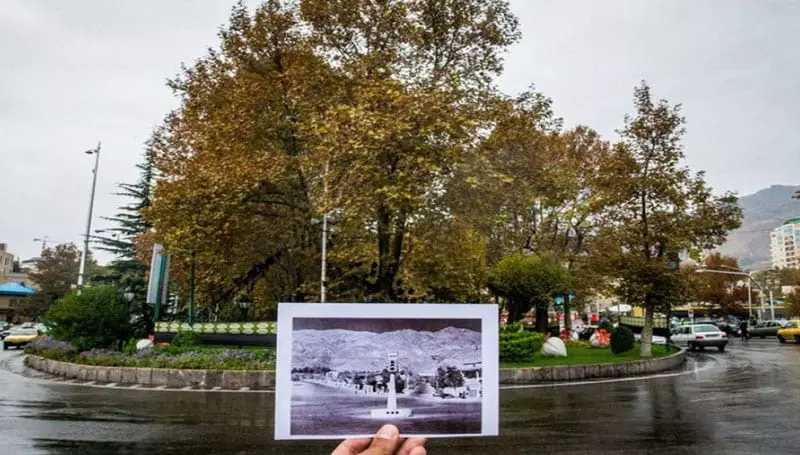
In the past, the Tajrish area was known as “Tajrashat,” and according to available documents, its history dates back to about 1,000 years ago. At that time, there was no mention of Tajrish Square, and a village atop a large garden hill near the present-day Roman Bridge was the first settlement of Tajrish residents. Tajrashat was one of the most pleasant areas in Tehran, where kings would go to enjoy the cool weather during the hot seasons.
Morteza Ravandi, a contemporary Iranian historian, mentioned in his book “The Social History of Iran” about Tughril’s journey to Tajrashat and his death in this village during the Seljuk period.
The closest village to the Tajrashat village was Dezashib. The vast garden hill between these two villages was called “Gol Bawkan,” and between this hill and Imamzadeh Qasem, there was also a garden called “Jannat Golshan.” Due to the increase in wolves around the villages of Tajrashat and Dezashib and the decrease in the safety of the locals, the residents of these villages migrated to the current location of Imamzadeh Saleh in Tajrish Square and the former Jannat Golshan Garden. Thus, the initial nucleus of the area and Tajrish Square was formed.
Over time, and throughout the years, other kings of Iran, especially during the Qajar and Pahlavi periods, selected the Tajrish area for residence for half of the year, further boosting Tajrish’s prosperity. The former Tajrish area consisted of three neighborhoods: “Bala” (Upper), “Paein” (Lower), and “Ghal’eh-Noo va Homah” (New Castle and Outskirts).
In Upper Tajrish, areas such as Ferdows Garden, Chaharrah Hasabi, Zaferanieh, and Elahiyeh were located, while Lower Tajrish comprised neighborhoods like Zahiroldoleh, Sedarat-e-Darbandi, Qeytarieh, Asadi, and Ferdowsi. Ghal’eh-Noo va Homah encompassed areas like Zaferanieh, Mahmoudieh, Navvab, and Jafarabad.

Tajrish Villages
In the past, Tajrish consisted of various villages. In fact, the well-known neighborhoods of this area today were once neighboring villages. Some of these villages remained with structural changes over time, while others have lost their names entirely. In these villages, people used to speak the Tajrish dialect, which is no longer common. One of the most famous villages of Tajrish is Koohsar Village.
The buildings and houses of the villages around Tajrish Square used to have a terraced structure, resembling the city of Masuleh. The residents of Tajrish villages came from different cities and belonged to various ethnic groups. The structure of these villages’ houses can be compared to the current structure of “Pas Ghaleh” village in the Darband area.
One of the main reasons for the formation of the Tajrish area in its current location was the presence of the Imamzadeh Saleh shrine at this point in Tehran. This shrine had a special place among the local people, and many Tajrish residents were inclined to start their businesses near this shrine. Thus, the prosperity of this area increased day by day, and Tajrish Square gradually reached its current status.
Today, there is no sign of villages with terraced houses and intertwined alley-gardens around Tajrish Square, as towers and modern buildings have replaced them. Despite significant changes in the appearance of the houses around Tajrish Square, some historical buildings in this area still stand and have been converted into various museums. Visiting the historical attractions of the Tajrish area is a delightful way to learn about the history of this region.
Tehran Tajrish Square Photo
- محله تجریش 25913
Things to do in tajrish shemiranat, tehran province, iran
Tajrish, located in the Shemiranat district of Tehran, offers a mix of cultural, historical, and recreational activities. Here are some highlights of things to do in Tajrish:
1. Tajrish Bazaar
- Description: The Tajrish Bazaar is one of the oldest and most vibrant markets in Tehran. It offers a colorful and bustling atmosphere with a wide variety of goods. Here, you can find fresh produce, spices, dried fruits, nuts, traditional Iranian sweets, and handicrafts. The bazaar is also an excellent place to observe daily life and the local culture.
- Tip: Take your time to explore the different stalls. Try some local delicacies like fresh dates or saffron-infused sweets. Bargaining is a common practice, so don’t hesitate to negotiate prices.
2. Imamzadeh Saleh Shrine
- Description: This religious site is a major pilgrimage destination, known for its beautiful blue-tiled dome and serene courtyard. The shrine is dedicated to Saleh, the son of Imam Musa al-Kadhim, the seventh Shiite Imam. The complex also includes a mosque and other facilities for pilgrims.
- Tip: Respect the local customs by dressing modestly and removing your shoes before entering the shrine. It’s a peaceful place for reflection and offers a unique insight into Iranian religious practices.
3. Darband
- Description: Darband is a picturesque area located at the base of the Alborz Mountains, serving as a gateway to hiking trails. The area is dotted with traditional teahouses, restaurants, and stalls selling snacks like roasted corn and traditional ice cream. The cool mountain air and lush scenery make it a popular spot for both locals and tourists.
- Tip: Start your hike early in the morning to enjoy the tranquility before the crowds arrive. After your hike, relax at one of the teahouses and enjoy a cup of Persian tea or a meal with a view.
4. Sa’adabad Palace Complex
- Description: This expansive complex includes multiple palaces and museums set in a large, wooded park. The Sa’adabad Palace Complex was once the summer residence of the Qajar and Pahlavi monarchs. Notable buildings include the Green Palace, known for its exquisite tile work, and the White Palace, which houses a museum of royal artifacts.
- Tip: Plan to spend at least half a day exploring the various museums and palaces. The grounds are beautiful for a leisurely walk, especially in spring and autumn when the foliage is stunning.
5. Cinema Iran
- Description: Cinema Iran is a popular movie theater in Tajrish where you can watch the latest Iranian films. The cinema offers a unique opportunity to experience Iranian culture through its vibrant film industry, which is renowned for its storytelling and artistry.
- Tip: Watching a local film can provide valuable insights into contemporary Iranian society and its cultural nuances. Look out for screenings of award-winning films by Iranian directors.
6. Palladium Mall
- Description: This modern shopping center offers a wide range of international and local brands, from fashion and electronics to home goods. Palladium Mall also features numerous dining options, a food court, and entertainment facilities such as a gym and a spa.
- Tip: Palladium Mall is ideal for a more upscale shopping experience. After shopping, enjoy a meal at one of the many restaurants that offer various cuisines, from Persian to Italian.
7. Niavaran Palace Complex
- Description: Located a short distance from Tajrish, the Niavaran Palace Complex consists of several buildings and museums set in beautiful gardens. It was used as the residence of the last Shah of Iran, Mohammad Reza Pahlavi. The complex includes the main Niavaran Palace, the Sahebqaraniyeh Palace, and the private library of the Shah.
- Tip: Don’t miss the Jahan Nama Museum, which houses a collection of art and artifacts from around the world. The gardens are perfect for a relaxing stroll.
8. Darakeh
- Description: Similar to Darband, Darakeh is another scenic area ideal for hiking and enjoying nature. The trail is lined with small streams, lush greenery, and local eateries offering traditional Iranian dishes.
- Tip: The trail is less crowded than Darband, making it a perfect choice for a peaceful nature experience. Try some local dishes like “ash reshteh” (a thick noodle soup) at one of the mountain-side eateries.
9. Museum of Music
- Description: This museum showcases the rich musical heritage of Iran, displaying traditional instruments, manuscripts, and recordings. The Museum of Music provides an in-depth look at the evolution of Iranian music and its influence on the country’s culture.
- Tip: Check the museum’s schedule for live performances or workshops, which can enhance your visit and provide a deeper understanding of Iranian music.
10. Bam-e Tehran
- Description: Also known as the Roof of Tehran, Bam-e Tehran offers panoramic views of the city, particularly spectacular at sunset. Located at a higher elevation, it provides a great escape from the hustle and bustle of the city.
- Tip: Wear comfortable shoes for the steep walk, and bring a camera to capture the stunning views. It’s a popular spot for both locals and tourists, especially in the evenings.
These activities offer a diverse range of experiences, from exploring traditional markets and religious sites to enjoying nature and modern amenities. Tajrish and the surrounding Shemiranat area provide a unique blend of cultural, historical, and recreational attractions that showcase the rich heritage and natural beauty of Tehran
Cafes and Restaurants in Tajrish Square
Tajrish Square in Tehran is one of the best options in the capital for dining out. Between Qods Square and Tajrish Square, there are various eateries catering to different tastes. Many tourists, after touring Tajrish, especially exploring the Tajrish Traditional Bazaar, head to these eateries for a meal.
In addition to the small food stalls, Tajrish is home to elegant and beautiful restaurants, some of which are among the oldest in Tajrish Square. Tajrish cafes are also great places to enjoy hot beverages in winter and refreshing natural juices in summer. Here are some of the most famous cafes and restaurants in Tajrish:
Florian Cafe Restaurant
Address: Roof Garden, Arg Commercial Complex
Phone: 021-22396758
Instagram: @florian_cafe
Opening Hours: Sundays from 10 AM to midnight, Mondays to Fridays from 9 AM to midnight
Price Range: Medium to High
Florian Restaurant is an Italian restaurant located in the Roof Garden of the Arg Commercial Complex in Tajrish, offering a charming and beautiful ambiance. At Florian Restaurant, you can order various Italian dishes such as pizza and pasta. The pasta in this restaurant is handmade, and the pizzas have a wide variety of toppings.
Florian Restaurant’s breakfast menu includes various options from traditional Iranian breakfast to English, French, Lebanese, Turkish, and Iranian breakfasts. If you prefer a quick and light breakfast, there are suitable options for you in this restaurant as well.
Florian’s salads have many fans, and their variety is also suitable. One of the most important features of Florian Restaurant is the existence of a separate kids’ menu on its food list. In the kids’ menu, you can order special spaghetti and pizzas for children.
In the cafe section of Florian, a wide variety of hot drinks and natural fruit juices are offered to customers. Various cakes, ice creams, smoothies, and milkshakes are also among the popular desserts at this cafe.
Rebelan Cafe Restaurant
Address: Tandis Shopping Center, 7th Floor
Phone: 021-245120
Instagram: @rebelangroup
Opening Hours: Daily from 7 AM to 10 PM
Price Range: Expensive
Rebelan Restaurant is one of the most luxurious restaurants in Tajrish Square and Tandis Shopping Center. This restaurant offers an extensive and specialized menu of various international cuisines such as pizza, pasta, sushi, steak, and seafood. Those interested in Iranian cuisine can also choose from various kebab platters and traditional dishes on the Iranian menu.
In the Rebelan Cafe section, known as one of Tehran’s luxurious cafes, a variety of cold and hot beverages, natural fruit juices, smoothies, and shakes are offered to customers. The interior space of this restaurant is suitable for hosting various birthday parties and family and friendly gatherings, and the Rebelan menu includes a section dedicated to various birthday cakes; therefore, this cafe-restaurant can be introduced as one of the best birthday cafes in Tehran.
The interior decorations of Rebelan Restaurant, like its luxurious and magnificent food menu, are exquisite. This restaurant has the capacity to accommodate up to 100 guests, and if you decide to hold an event there, be sure to reserve your table or tables in advance. Rebelan Restaurant guests can use the exclusive parking lot of Tandis Complex for parking their cars.
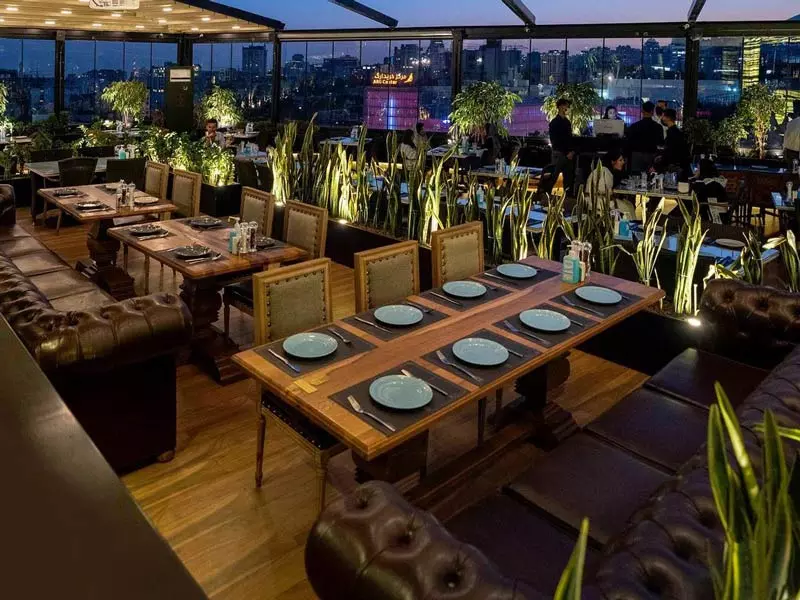
Rouhi Cafe and Restaurant
Address: Gholam Jafari Street, Above Tandis Shopping Center, No. 12
Phone: 021-91091080
Instagram: @rouhi.group
Opening Hours: Daily from 12 PM to 5 PM and 8 PM to 11 PM
Price Range: Medium to High
Rouhi Cafe Restaurant is a chain with four restaurants in various areas of Tehran, offering traditional Iranian dishes to international dishes in special packaging both in-house and for takeaway. One of the most important features of this restaurant is the presence of several vegetarian dishes on its menu for those interested in vegetarian meals.
Among the dishes at Rouhi Restaurant, homemade dishes such as kuku sabzi and kuku sibzamini catch the eye, which have a special aroma and taste. Other authentic dishes at Rouhi Restaurant include kaleh joosh, dampokhtak with eggs, ghimeh nesar, loobia polo, kofteh tabrizi, and adas polo. Many dishes at this restaurant are cooked in two versions, with meat and without meat, and enthusiasts of each category can choose their favorite dishes from the menu.
In addition to the common beverages, Rouhi Restaurant also prepares various authentic Iranian sherbets with unique flavors for its customers. The staff of this restaurant, with the slogan “Eat with Love,” also serve the highest quality appetizers and condiments to customers. Rouhi Restaurant is located near Tandis Shopping Center.
Ayaar-e-Shemroon Restaurant
Address: Shahid Darbandi Street, No. 79
Phone: 021-22266444
Instagram: @ayareshemroon
Website: ayareshemroon.ir
Opening Hours: Daily from 11 AM to 12 AM
Price Range: Medium to High
Ayaar-e-Shemroon Restaurant is among the traditional restaurants serving authentic Iranian cuisine in the southwest corner of Tajrish Square. In this restaurant, you can order various homemade traditional dishes such as lubiyapolo, kebab tabei, kofteh tabrizi, adas polo, and albaloo polo.
Moreover, delicious dishes like various kebabs, baghali polo, and morashe polo catch the eye on the Ayaar-e-Shemroon Restaurant menu. Traditional Iranian stews in this restaurant are served with saffron tahchin.
The interior of Ayaar-e-Shemroon Restaurant is very modern and contemporary. The traditional drinks in this restaurant are suitable options to accompany the meal, especially on hot summer days.
Ayaar-e-Shemroon Restaurant utilizes traditional Iranian beverages such as saffron sherbet, khakshir, tokhm sharbati, and lemonade to entertain its customers.
Customers at Ayaar-e-Shemroon Restaurant can also order various fresh and natural fruit juices both in-person and online. The restaurant’s website features a complete list of foods and beverages that will be delivered to you with appropriate packaging upon ordering.
Baghche Traditional Restaurant
Address: Tajrish Bazaar, Masjed Alley, Next to Masjed Seyyed al-Shohada
Phone: 021-22718189 and 0921-1001303
Instagram: @baghche.restaurant
Opening Hours: Daily from 9 AM to 11 PM
Price Range: Medium to Low
Baghche Restaurant is a traditional eatery located in Tajrish Bazaar, hosting tourists from breakfast to dinner. The breakfast menu at this restaurant features popular Iranian breakfast dishes such as lubia stew, omelette, and traditional Iranian breakfast; English breakfast is also served at Baghche Restaurant.
Inside Baghche Restaurant, wooden tables and chairs with traditional tablecloths are used. The colorful glass windows of the entrance evoke nostalgic memories of old houses for tourists. A part of this restaurant is decorated with antique utensils, where stone and china dishes are arranged alongside samovars and red-flower pitchers.
Among the most popular dishes at Baghche Restaurant are sabzipolo ba mahi, kabaab barg and loqma, baghali polo ba gosht, and morgh-e shekam par. Additionally, its dizi sangi is one of Tehran’s delicious dizi dishes. This restaurant also offers takeaway services, allowing customers to order their food remotely. If you plan to explore Tajrish Bazaar, taking a break and enjoying a delicious meal at Baghche Restaurant will double your market experience.
Atminan Chelo Kebab Restaurant
Address: Tajrish Bazaar, Opposite Samaei Passage
Phone: 021-227163230
Opening Hours: Daily from 11 AM to 11 PM
Price Range: Inexpensive
Atminan Chelo Kebab Restaurant is one of the oldest traditional restaurants in Tajrish Bazaar serving authentic Iranian dishes. With over 100 years of history, this restaurant still attracts many tourists during midday hours.
Atminan Restaurant, with its nostalgic ambiance, maintains its traditional decor. Authentic dishes like joojeh kebab, kabaab loqma, kabaab barg, baghali polo ba goosht, and zereshk polo ba morgh are among the most popular dishes in this restaurant.
Fans of various Iranian stews can experience the delicious taste of dishes like gheimeh and fesenjan at Atminan Restaurant. This eatery is a short distance from the Astaneh-ye Saheb az-Zaman shrine, and many tourists dine at Atminan Restaurant after visiting this shrine.
Shemroon Kabab Restaurant
Address: Northeast side of Tajrish Square
Phone: 021-22746007
Food Delivery Phone: 1775
Instagram: @shemroonkabab
Website: shemroonkabab.com
Opening Hours: Daily from 11 AM to 11:45 PM
Price Range: Medium to High
Shemroon Kabab Restaurant is one of the popular Iranian restaurants in Tehran, with branches in Tajrish Square, Niavaran Street, and Ovin Street. The Tajrish Square branch of Shemroon Kabab is one of the busiest branches of this restaurant, accepting both dine-in and online orders. This branch is the first restaurant in the Shemroon Kabab chain, which started its operation in 1390 (2011).
The menu at Shemroon Kabab Restaurant features various delicious Iranian kebabs, with no mention of stews or other traditional Iranian dishes; in fact, Shemroon Kabab is a suitable choice for kebab enthusiasts. Shishlik, lamb kebab, chicken kebab, and koobideh are the main dishes of this restaurant.
At Shemroon Kabab Restaurant, you can also order authentic and popular Iranian appetizers such as mast-o-khiar, mast-o-bademjan, and stuffed olives.
The slogan of the Shemroon Kabab restaurant chain is “Shemroon, a delicious brand,” and one of its most important features is the quick delivery of food to various parts of Tehran.
Kabooky Restaurant
Address: Beginning of Maleki Street (Saadabad), No. 12
Phone: 021-22731596 and 021-22709808
Instagram: @kabookyfamily
Website: www.kabooky.com
Opening Hours: In the first six months of the year from 11:30 AM to 12:30 AM and in the second six months of the year from 11:30 AM to 11:30 PM
Price Range: Medium (Economical)
Kabooky Restaurant is one of the oldest restaurants in Tajrish Square and one of the best fast-food restaurants in Tehran, offering various fried chicken dishes with the freshest ingredients throughout its years of operation. Before the Islamic Revolution, this restaurant was the sole representative of the KFC restaurant chain in Iran, which continued its operation under the name Kabooky after the brand exited Iran. This trademark was officially registered in 1371 (1992), and branches in Tajrish Square and Pasdaran Street were launched. Today, Kabooky Restaurant’s Shahrak-e Gharb branch has also been added to the restaurant chain.
One of the most important features of Kabooky restaurants is the non-use of frozen chickens in cooking various fried chicken dishes. The menu of this restaurant includes dishes such as wings, thighs, tenders, barbeque, and kabooky fillet, named after the Kabooky brand. This restaurant also offers a fried chicken sandwich to its customers, which is the initiative of Kabooky’s chefs. The sauces used in Kabooky restaurant are handmade and prepared according to the customers’ taste.
Lamiz Coffee
Branch 1 Address: Beginning of Maleki Street, No. 6
Branch 1 Phone: 021-22708061
Branch 1 Opening Hours: Daily from 7 AM to 11:30 PM
Branch 2 Address: Beginning of Maleki Street, No. 4
Branch 2 Phone: 021-26851876
Branch 2 Opening Hours: Daily from 7 AM to 10:30 PM, Fridays from 8 AM to 10:30 PM
Branch 14 Address: Beginning of Valiasr Street, Next to Eghtesad Novin Bank (View on Map)
Branch 14 Phone: 021-22716620
Branch 14 Opening Hours: Daily from 7 AM to 11:30 PM
Instagram: @lamizcoffee
Lamiz Coffee cafes are among the most popular chain cafes in Iran, specializing in various types of coffee and hot beverages.
The Lamiz chain produces the best and highest quality beverages by sourcing the finest raw materials from coffee farms worldwide. In fact, Lamiz’s staff are among the most professional coffee producers and suppliers in Iran, offering a complete variety of coffee types on the menu of these chain cafes.
There are three branches of Lamiz Coffee operating in Tajrish Square, Tehran. In addition to offering quality beverages, these cafes also provide packaged products to customers.
The Lamiz menu, one of the best cafes in Tehran, includes various types of teas and chocolate drinks. If you’re a fan of various hot drinks and diverse coffees, make sure to visit one of the Lamiz Coffee branches during your visit to Tajrish.
Osho Cafe
Address: Beginning of Valiasr Street, Next to Bank Keshavarzi (View on Map)
Phone: 021-22703535
Instagram: @osho.cafe
Opening Hours: Daily from 9 AM to 11:30 PM
Price Range: Affordable
Osho Cafe offers a cozy and intimate atmosphere in Tajrish Square, suitable for relaxing after exploring the hustle and bustle of Tajrish. This cafe serves various cold and hot beverages such as shakes, smoothies, and coffees to customers.
The coffee variety on Osho Cafe’s menu is extensive, and fans of this hot beverage can enjoy various types of high-quality coffee in this cafe. Among Osho Cafe’s coffees, organic drinks are also noticeable, brewed in a traditional style.
Natural herbal teas have also dedicated a section of Osho Cafe’s menu to themselves. Those interested in cakes and desserts have various options to choose from in this cafe. The daily food menu of Osho Cafe includes various pizzas, burgers, and pastas. The variety of appetizers and salads in this cafe is also high and caters to customers’ tastes.
If you enjoy having breakfast in cozy cafes, Osho Cafe offers various omelets, English breakfasts, and pancakes for breakfast. On Friday nights, this cafe hosts music events that are very popular among fans.
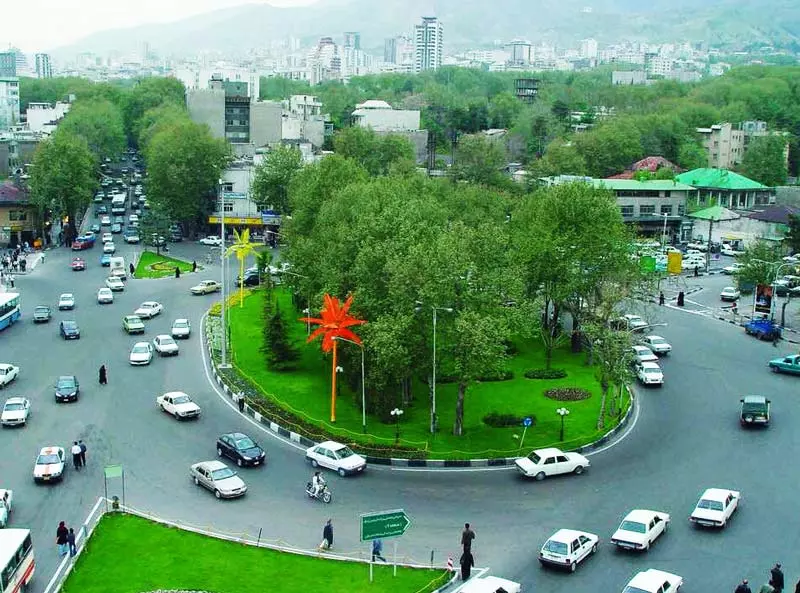
Tajrish Square Attractions
Imamzadeh Saleh
Address: Southeast corner of Tajrish Square (View on Map)
Phone: 021-22748010
Instagram: @saleh129_ir
Visiting Hours: Daily from 8 AM to 12 AM
Imamzadeh Saleh is the most famous tourist attraction in Tajrish Square, located near the Tajrish Bazaar. According to available narratives, this shrine belongs to one of the brothers of Imam Reza (AS) and holds a special place among the residents of the capital, especially the people of Tajrish.
The main building and shrine of Imamzadeh Saleh were constructed in the fifth century AH (Islamic calendar), but they were destroyed by the Mongol invasion of Iran in 617 AH. Experts estimate the shrine’s antiquity to be from the Ilkhanate period based on the tombstones found in parts of its precinct.
The reconstruction of the main sections of Imamzadeh Saleh was carried out during the Ilkhanate rule, and the expansion of other sections and decorations of the buildings date back to the Safavid and Qajar periods.
The carving of the portal’s lintel in the north portico of Imamzadeh Saleh is dated to the year 1210 AH, indicating the time of Hulagu Khan’s reign. Many of the graves surrounding the shrine date back to the Qajar era. During this period, more than 150 notable figures in the vicinity of Imamzadeh Saleh were buried.
The development and reconstruction plan of the shrine and its surroundings began in 1374 AH, leading to significant changes in this complex. One of the notable events in Imamzadeh Saleh’s history was the fire and subsequent cutting down of its ancient plane tree courtyard. The environment of this 700-year-old plane tree had reached a height of 15 meters and was registered as a national heritage of Iran, but it caught fire during the landscaping changes and was eventually cut down by the municipality.
Imamzadeh Saleh has convenient access from Tajrish Square, and behind its precinct on Darbandi Street, public parking is also available for personal vehicles.
Tajrish Bazaar
Address: Southeast corner of Tajrish Square (View on Map)
Visiting Hours: Daily from 9 AM to 10 PM
Tajrish Bazaar is one of the oldest markets in Tehran, located in the Shemiranat district and the southeast corner of Tajrish Square. Imamzadeh Saleh is situated at the western end of this bazaar, and many tourists visit both of these attractions in Tajrish Square in a single day. More than 400 shops and commercial units operate in Tajrish Bazaar, offering a wide variety of products and goods. Various attractions are also found in the vicinity of Tajrish Bazaar, some of which reflect the market’s long history.
The exact antiquity of Tajrish Bazaar is unknown. The old residents of the Tajrish area and local merchants consider the market’s history to be more than 150 years old. Some of the existing buildings in Tajrish Bazaar also date back more than 200 years, but the oldest documents related to the emergence of the market in this area date back to about 70 years ago. According to experts, the formation of Tajrish Bazaar in its current form has had close ties to the expansion of the Tajrish neighborhood. This area was once a resort with many fruit orchards, and over time, the orchard workers turned to buying and selling goods and renting rooms.
One of the notable attractions of Tajrish Bazaar is a famous gathering place known as “Takieh Tajrish.” This gathering place has been the venue for religious ceremonies and community gatherings for many years. Tajrish Bazaar is divided into two sections: the soldier’s entrance and the covered alcoves inside. Today, this market sells goods such as handicrafts, fabrics, toys, bags and shoes, and various food items. The fruit and vegetable stalls in Tajrish Bazaar are also among the most popular sections of this market.

There are various ways to visit Tajrish Bazaar. The Tajrish Metro Station, Valiasr Street bus lines, and various taxis from different parts of the city will take you to Tajrish Square, where you can easily access Tajrish Bazaar.
Tandis Shopping Center
Address: North side of Tajrish Square, beginning of Jafari Street (View on Map)
Phone: 021-22744695, 021-22731010
Instagram: @tandiscenter
Visiting Hours: Daily from 10 AM to 10 PM (restaurants open until 11:30 PM)
Tandis Center is one of the commercial complexes in the north of Tajrish Square known as Tandis Center. The entrance to this complex is located at the beginning of Jafari Street, and it also has its own parking lot.
Tandis Center opened in 2004 and was one of the few luxury malls in Tehran at the time, which quickly gained popularity. The Tandis Mall has 14 floors, with five floors for offices, four floors for commercial purposes, and five additional floors for parking.
When Tandis Mall started operating, it hosted a collection of the most famous international brands. Today, most of the shops in this complex are women’s and men’s clothing boutiques. Stores selling cosmetics and perfumes also have a significant presence in this mall. In total, 177 commercial units operate in Tandis Center.
Among the recreational and welfare facilities of Tandis Mall are air conditioning systems, ATMs, specialized skin and laser centers, currency exchange offices, car wash, café shops, buffets, restrooms, private parking, prayer room, and various restaurants.
If you’re traveling to Tandis Shopping Center with your own car, you should enter the parking lot of this complex from Fanakhosro Street to Jafari Street.
Arg Commercial Complex
Address: Northwest of Tajrish Square, beginning of Maleki Street (View on Map)
Phone: 021-22396121
Instagram: @arg_tajrish
Visiting Hours: Daily from 10 AM to 10 PM
Arg Commercial Complex is one of the luxury shopping centers in the Tajrish area, located in the northwest of Tajrish Square. This mall has 10 floors divided equally between commercial and parking areas. The construction of the Arg complex began in 2012, and it opened in 2014.
Arg Mall offers suitable recreational facilities for tourists. One of the notable features of this commercial center is its beautiful exterior lighting, which attracts tourists’ attention at night.
Arg Mall boasts a wide variety of children’s, women’s, and men’s clothing brands. Stores selling accessories, jewelry, and cosmetics and hygiene products also operate in this mall. The second floor of the Arg Mall is dedicated to gold shops, jewelry stores, and luxury watch shops. Other products available in the commercial units of this mall include bags, shoes, digital devices, mobile phones, and leather goods.
“Funtime Funfair” is one of Tehran’s best amusement parks and a popular recreational attraction in the Arg Mall, located on the third floor of this commercial center. Next to Funtime Funfair, there are a food court and five cinema halls that cater to the tastes of various tourists. Other beautiful and scenic areas in the Arg Complex include the rooftop garden, located on the sixth floor. The rooftop of Arg offers a beautiful and scenic view of Tajrish Square, and its restaurant provides a suitable environment for tourists to relax.
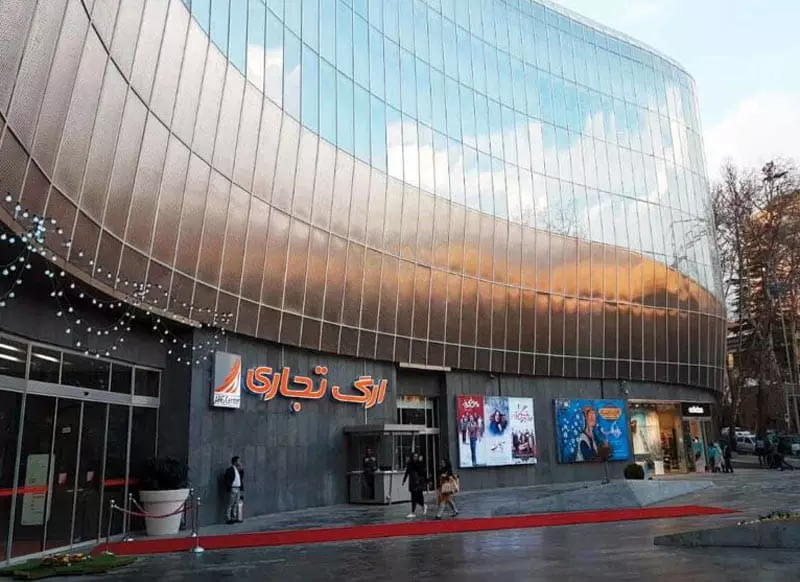
Ghaem Passage (Bazaar Ghaem)
Address: Southeast of Tajrish Square, next to Tajrish Bazaar (View on Map)
Phone: 021-2803
Instagram Pages: @bazaarghaem and @_ghaem_tajrish
Visiting Hours: Daily from 9:30 AM to 10 PM
Ghaem Passage, also known as Ghaem Bazaar, is one of the oldest commercial complexes in Tajrish Square, located near the traditional bazaar. Access to this commercial complex is possible from Shahrdari Street. This passage does not have private parking, so you must use public parking lots around the complex for parking your car.
Ghaem Bazaar has six floors, offering a wide variety of shops. On the sixth floor of this passage, the artworks of young artists are exhibited. Art workshops are also located on this floor, and exhibitions are held in its galleries throughout the year. Many artists and art enthusiasts visit the Ghaem commercial complex to see the artworks on display.
One of the features of Ghaem Passage is the division of floors based on the merchandise sold in the shops. For example, the first and second floors of Ghaem Passage are dedicated to stores selling gold, jewelry, watches, and silver. Other sections of this commercial center include household goods and bags and shoes on the third floor, family clothing stores on the fourth floor, and electronic devices and cosmetic and hygiene products on the fifth floor. Cafes and food courts are also available on the fifth and sixth floors.

Sightseeing around Tajrish Square
Imamzadeh Qasem (AS)
Address: Dr. Shariati Street, Niaouaran Street (Shahid Bahonar), Mozhdeh Intersection (Intersection of Maqdesi Street) (View on Map)
Closest Distance from Tajrish Square: 1.5 kilometers northeast of Tajrish Square
Visiting Hours: Daily from 7 AM to 11 PM
Entry Fee: Free
Imamzadeh Qasem (AS) in the north of Shemiranat is one of the oldest attractions in the Tajrish area. This Imamzadeh is located at an altitude of 1,700 meters above sea level in the foothills of Mount Sarchal and the village of Dezh Aliyeh Tajrish. The Golabdarreh River, one of Tehran’s important rivers, passes east of Imamzadeh Qasem, cooling the climate of this area.
The shrine of Imamzadeh Qasem (AS) belongs to one of the descendants of Imam Hasan Mojtaba (AS). It is also known as Imamzadeh Golabdarreh, and the residents of Tajrish and the surrounding villages have a great interest in this shrine. The surroundings of Imamzadeh Qasem (AS) are filled with fruit gardens, and in the past, this area was one of the favorite summer resorts of the kings. The building and tomb of Imamzadeh Qasem (AS) were built during the rule of the Buyids and by the order of “Adud al-Dawlah Deylami,” known as “Fana Khosrow.” At that time, there were no decorations in the building of this shrine. The wooden shrine of Imamzadeh dates back to the Seljuk period and was built by the order of Kamal al-Din Seljuk. The expansion of the building of Imamzadeh Qasem (AS) and its interior decorations were carried out during the Safavid rule and by the order of Shah Tahmasb I. Some of the external decorations of this Imamzadeh, such as the tiled dome, were also added during the Qajar rule.
To visit Imamzadeh Qasem (AS), you can use taxis along the Imamzadeh neighborhood route in Tajrish Square. This shrine becomes crowded on weekends and during religious ceremonies, and it is quieter on weekdays.
Ferdows Garden
Address: Valiasr Street, between Zaferanieh Intersection and Tajrish Square, Ferdows Garden Street (View on Map)
Closest Distance from Tajrish Square: 1 kilometer southwest of Tajrish Square
Phone: 021-42725882 and 021-22740454
Instagram Page for Cinema Museum: @irancinemamuseum
Visiting Hours: Cinema museum halls from 9 AM to 7 PM, other sections of the garden from 9 AM to 12 AM
Entrance Fee to the Garden and Cinema Museum (in 2023): 5,000 Tomans
Ferdows Garden is one of the most beautiful gardens in northern Tehran, located in the Tajrish area, housing the Cinema Museum. Since 2002, the Cinema Museum has been established in this garden, attracting many artists ever since. The history of this garden dates back to the Qajar dynasty and its name is prominent in the list of Iran’s national heritage.
Today’s Ferdows Garden is actually a small part of a vast garden during the Qajar era. The summer mansion of Ferdows Garden was built by the order of Prime Minister Mohammad Shah, “Haji Mirza Aghasi.” During the reign of Naser al-Din Shah, this mansion was passed to the daughter and son-in-law of the Shah, but later Ferdows Garden changed hands among various owners. During the Pahlavi era, Shapour Tajrish High School was located in the mansion of this garden. After the victory of the Islamic Revolution, this building came under the control of the Islamic Republic of Iran Broadcasting (IRIB) and was transformed into a museum garden and cinema museum.
Ferdows Garden covers an area of 20,000 square meters, with the mansion area reaching 1,000 square meters. The garden area is adorned with lush vegetation, towering trees, and colorful and beautiful flower pots, while the main mansion features beautiful plasterwork.
Various sections of the Cinema Museum include halls for pioneers, contemporaries, international figures, celebrities, as well as sections like theaters, children and youth, defense, sound and dubbing, Ali Hatami room, and Farhad’s house.
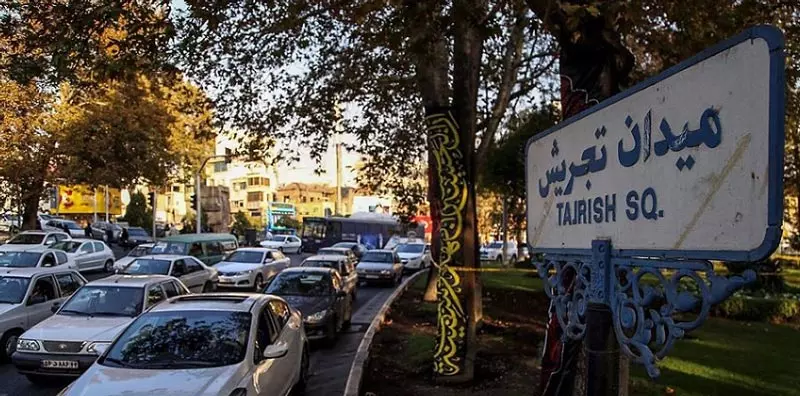
Facilities at Ferdows Garden include film screening halls, Cafe Viona, bookstore, cultural products shop, and handicraft booths. Ferdows Garden is located at the northern end of Valiasr Street, near Tajrish Square. To visit this garden, you can use BRT buses and taxis along Valiasr Street from south to north, Tajrish Metro, and private vehicles.
Saadabad Palace Museum
Address at Darband Entrance: Tajrish Square, Shahid Gholam Jafari Street, South Side of Darband Square (View on Map)
Address at Zaferanieh Entrance: Valiasr Street, Shahid Fallahi Street (Zaferanieh), End of Shahid Kamal Taheri Street (View on Map)
Closest Distance from Tajrish Square: 1.8 kilometers northwest of Tajrish Square
Phone: 021-27940000
Website: sadmu.ir
Visiting Hours: First six months of the year, daily from 9 AM to 6:30 PM (ticket sales until 5 PM), second six months of the year, daily from 8 AM to 5 PM (ticket sales until 3:30 PM)
Ticket Price (in 2023): 5,000 Tomans
Saadabad Historical and Cultural Complex is one of Tehran’s most famous palace museums with a history dating back to the Qajar period. This complex was once a residence of the Qajar and Pahlavi kings in Tehran, which has now turned into one of Tehran’s attractions with various museums. The museums of the Saadabad Complex are housed in various palaces within it. Saadabad Complex is the largest collection of palaces remaining from the monarchy period in Iran.
The Saadabad Historical Complex houses cinema halls, tennis courts, and various administrative and historical buildings. The Saadabad Amphitheater, also known as Ivan Atar, hosts exquisite music concerts and valuable theater performances. Various greenhouses and the central library are also part of this historical complex.
Undoubtedly, the most important parts of the Saadabad Historical Complex are its palaces, which have now been converted into various museums and are considered among the best museums in Tehran. The names of the palace museums of Saadabad are as follows:
- Ahmad Shahi Palace
- Shahvand Palace or Green Palace
- White Palace
- Private Palace or Former Natural History Museum
- Black Palace or Asoud (Fine Arts Museum)
- Shams Palace (Royal Costume Museum)
- Ashraf Palace (Royal Utensils Museum)
- Queen Mother’s Palace (Presidential Building)
- Bahman Palace (Management Building)
- Shahram Palace (Military Museum)
- Queen Esmaat Dowlatshahi Palace (Master Farshchian Museum)
- Crown Prince Reza Pahlavi’s Old Palace (Master Behzad’s Miniature Museum)
- Farahnaz and Alireza Palace (Master Mir Emad’s Calligraphy Museum)
- Farah Pahlavi Palace (Negarestan Museum)
- Queen Touran Amirsoleimani Palace (Faces Museum)
- Leila Pahlavi Palace (Master Abkar’s Miniature Museum)
- Omidvar Brothers Museum (Former Royal Carriage House)
- Water Museum (Former Royal Court Ceremonies Venue and Army Protection Office)
- Royal Albums and Documents Museum (Former Imperial Guard Building)
- Royal Automobile Museum
To visit Saadabad Palace, you have various routes from Tajrish Square. If you’re traveling by private vehicle, you should take the Zaferanieh route on Valiasr Street. You can also choose one of the Tajrish Square lines to Asif or Darband with taxi lines and walk in the middle of the route. However, with a taxi, you should walk for about 10 minutes during the journey.
For information on the opening hours of various museums and their ticket prices, you can visit the Saadabad Historical Complex website.
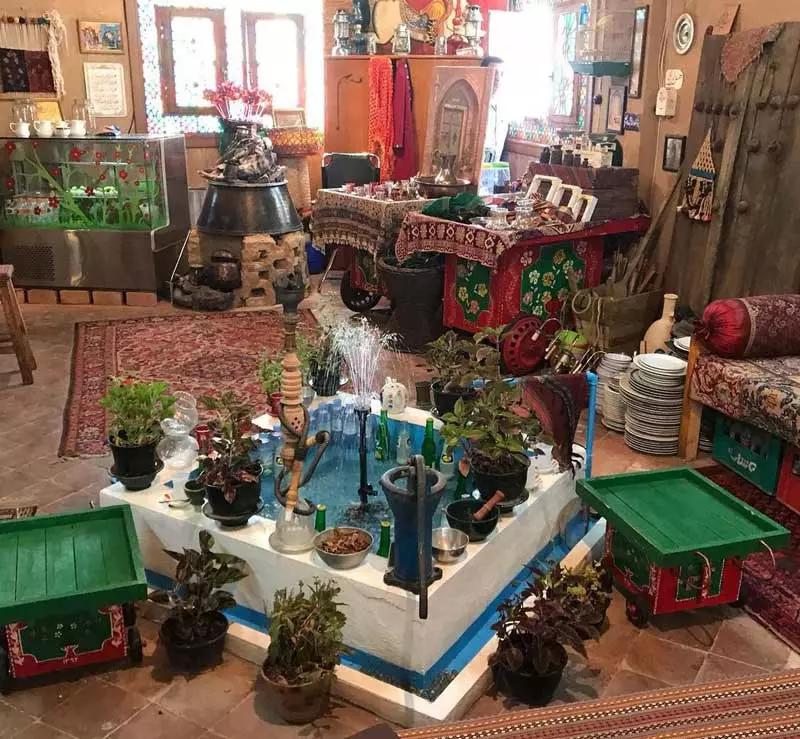
Tehran Music Museum
Address: Tajrish Square, Shahid Darbandi Street, Takhti Intersection, Museum Street (View on Map)
Closest Distance from Tajrish Square: 900 meters south of Tajrish Square
Phone: 021-22672785
Instagram Page: music-museum-ir@
Visiting Hours: Daily except Saturdays, from 10 AM to 5 PM
Ticket Price (in 2023): 40,000 Tomans
Tehran Music Museum, located in the south of Tajrish Square, is one of the best attractions in the capital for music enthusiasts. This museum is housed in a three-story building covering an area of over 3,600 square meters.
The museum features around 240 musical instruments grouped into various categories such as string, wind, and percussion instruments. The display halls in this museum offer a complete archive of various types of music to visitors.
The Tehran Music Museum is located in an old building with a history of over 50 years and began its activities in 2009. Among the various sections of the Tehran Music Museum are the museum’s treasury, audiovisual archive, specialized library, instrument-making workshop, instrument storage warehouse, and audiovisual section.
Among the musical works and instruments in the Tehran Music Museum, some are dedicated to renowned Iranian music masters. The string and wind instrument halls are located separately on the ground floor. The halls for percussion and traditional instruments are also located on the ground floor, next to the string and wind instruments. The halls for donated instruments by artists and the audiovisual archive of this collection are located on the upper floor. The best way to access the Tehran Music Museum is through BRT buses and taxis on Valiasr Street.
Zahir al-Dowleh Cemetery
Address: Qods Square, Darband Street, Zahir al-Dowleh Street (View on Map)
Closest Distance to Tajrish Square: 800 meters northeast of Tajrish Square
Visiting Hours: Fridays, 10 AM to 12 PM for women, and 1 PM to 3 PM for men
Admission: Free
Zahir al-Dowleh Cemetery is one of the oldest cemeteries in northern Tehran, which has become a popular attraction in the capital due to the presence of the tombs of many artists and politicians. Beautiful and artistic gravestones adorn the corners of this cemetery, dedicated to famous artists and individuals. Many of the graves in Zahir al-Dowleh Cemetery belong to members of a family or dynasty.
Mirza Ali Khan Dolatshahi Qajar, known as Zahir al-Dowleh, was the court minister of Naser al-Din Shah Qajar. Zahir al-Dowleh passed away due to a heart attack in 1924 and was buried in his private garden. After his burial, this garden was named Zahir al-Dowleh Cemetery, and over time, some of his relatives were also buried there. However, since 1961, no burial permits have been issued for Zahir al-Dowleh Cemetery. Only with official permission, burial was possible in this cemetery from the 1960s to the 1970s, and the last burial ceremony there dates back to 1980.
Zahir al-Dowleh Cemetery was registered as a national heritage site in 1999. Among the famous personalities buried in this cemetery are Malek al-Shoara Bahar, Abolhassan Saba, Mohammad Hossein Loqman, Rahi Mo’ayyeri, Parviz Yahaghi, Iradj Mirza, Dariush Rafii, Ghamar ol-Molouk Vaziri, Rouhollah Khaleghi, Morteza Mahjoubi, and Forough Farrokhzad.
To visit Zahir al-Dowleh Cemetery, first head towards Qods Square. You can reach this cemetery with a 20-minute walk from Tajrish Metro Station. If you prefer, you can use private transportation or rental taxis for direct access to Zahir al-Dowleh Cemetery. Visiting this cemetery is only possible on Fridays with prior coordination and separately for men and women.
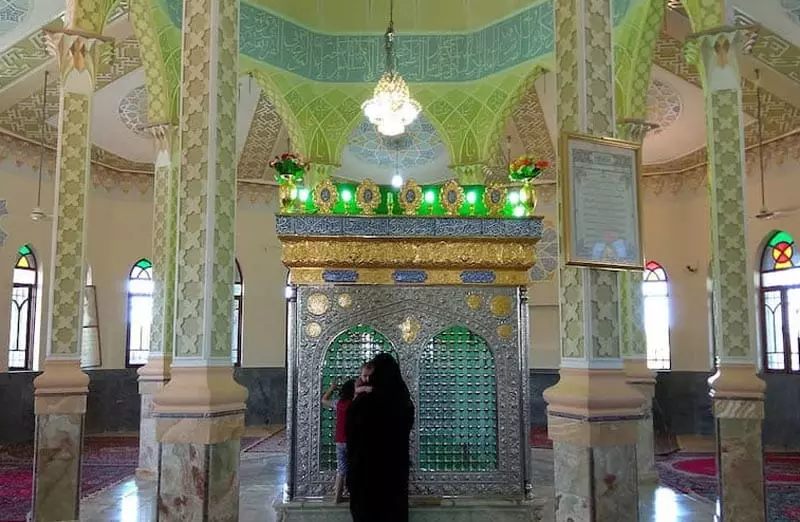
Dr. Hessaby Museum
Address: Tajrish Square, Shahid Darbandi Street, Hessaby Intersection, Dr. Hessaby Street (View on Map)
Closest Distance to Tajrish Square: 1 kilometer south of Tajrish Square
Phone: 021-22231676
Dr. Hessaby Foundation Instagram Page: prof.hessabyfoundation@
Visiting Hours: During the week from 9:30 AM to 12:30 PM and 2 PM to 5 PM (with prior inquiry), Fridays from 9 AM to 5 PM
Ticket Price: 10,000 Tomans
Dr. Hessaby Museum was established by his family shortly after the death of Professor Hessaby and is located on the third floor of his personal residence. This museum showcases a collection of personal belongings, scientific documents, certificates of appreciation, old photographs, and writings of Dr. Hessaby.
Among the exhibits in the Dr. Hessaby Museum, some are gifts presented to Professor Hessaby. These items include paintings, calligraphy works, carpets, and handicrafts.
The building of Dr. Hessaby’s house dates back to 1931. In the outer courtyard of the museum, there is a beautiful garden where strolling and observing its beautiful birds and animals is enjoyable. From Tajrish Square, you can reach Dr. Hessaby Museum with a 15-minute walk. Make sure to inquire before visiting this museum.
Time Museum
Address: Valiasr Street, Falahi Street (Zaferanieh), Corner of Perzian Baghdati Street, No. 12 (View on Map)
Closest Distance to Tajrish Square: 1 kilometer west of Tajrish Square
Phone: 021-22417336-7
Instagram Page: timemuseum.cibm@
Visiting Hours: Daily except Saturdays and official holidays, from 9 AM to 5 PM
Ticket Price: 32,000 Tomans
Time Museum was established in 1999 in the garden area with a historical background from the Qajar period. This garden, formerly owned by Moayer al-Mamalek, the son-in-law of Naser al-Din Shah, had no buildings.
The first building of the Time Museum was constructed after 1925 by its subsequent owners. Substantial changes were made to this building between 1966 and 1977, with artistic gypsum works added.
The Time Museum showcases interesting examples of various Iranian, French, Swiss, English, and German antique clocks for public viewing. Some sections of the museum also display clocks donated by or belonging to Iranian celebrities, including wall clocks, table clocks, pocket watches, and wristwatches. The clocks of Professor Mahmoud Hessaby and the Sun Clock of Naser al-Din Shah are among the most famous.
In the garden area of the Time Museum, various types of sundials, sand clocks, water clocks, and fuel clocks from different historical periods are also on display. Facilities such as a cafe-restaurant, prayer room, and Time Gallery are incorporated into this complex. The Time Museum was listed in Iran’s National Heritage in 2003.
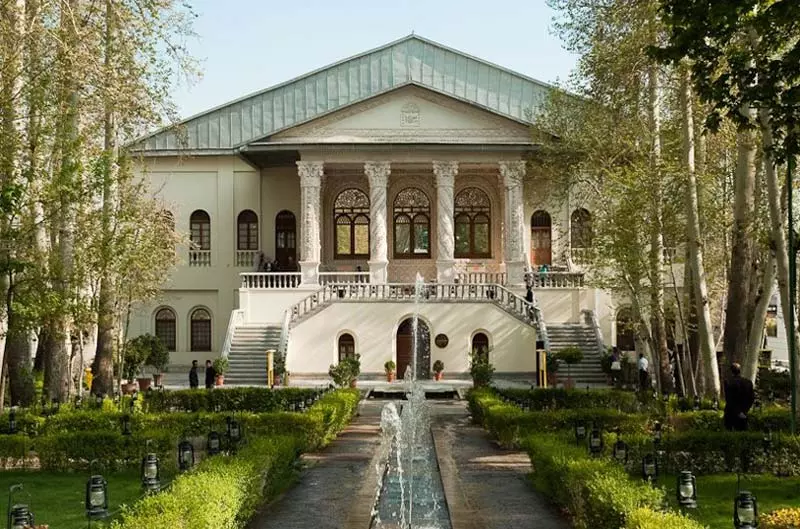
Iranian Art Garden Museum
Address: Tajrish Square, Shahid Darbandi Street, Dr. Hessaby Street, Opposite Dr. Hessaby Museum (View on Map)
Distance to Tajrish Square: 1.2 kilometers southwest of Tajrish Square
Phone: 021-22686063-5
Instagram Page: iamg_ir@
Visiting Hours: Daily from 9 AM to 11 PM
Ticket Price: 3,500 Tomans
Iranian Art Garden Museum is one of the tourist attractions in the Tajrish area, offering various and entertaining sections. This museum garden hosts interesting exhibitions and workshops throughout the year, attracting enthusiasts of various artistic branches.
The green space of the Iranian Art Garden Museum showcases miniature models of historical buildings from different cities of Iran. These models were commissioned by the Iranian government before the revolution and crafted by Italian artists. Other sculptures by Iranian artists in the museum garden are also worth visiting. Visitors interested in cultural products can buy handicrafts and artistic workshop products in this complex.
Iranian Art Garden Museum was established as a private garden in 1931. After the Islamic Revolution, this garden was transformed into a public park and underwent extensive renovations over the years. Different sections of this complex include the Pardis Gallery, handicraft booths, bookstores, cultural product stalls, and educational workshops. The cafe-restaurant “Jaryan” is also one of the popular spots in the Iranian Art Garden Museum.
In this article, we introduced Tajrish Square in Tehran. You can also share your experiences of touring Tajrish in Tehran with us and other Gulf City Pedia users.
Frequently Asked Questions
Where is Tajrish Square located?
Tajrish Square is situated in Tehran Province, Shemiranat County, Lavasanat District, in the Tajrish area.
How can we reach Tajrish Square by metro?
Tajrish Station is the first station on Line 1 of the Tehran Metro, traveling from north to south. This station is located at Qods Square, and you can reach Tajrish Square by walking approximately 10 minutes from there.
What are the working hours of Tajrish Bazaar?
Tajrish Bazaar is open every day from 9 AM to 10 PM.
Is Tajrish in the north of Tehran?
Yes; Tajrish Square is located in the central area of Shemiranat County in the northern part of Tehran Province.



